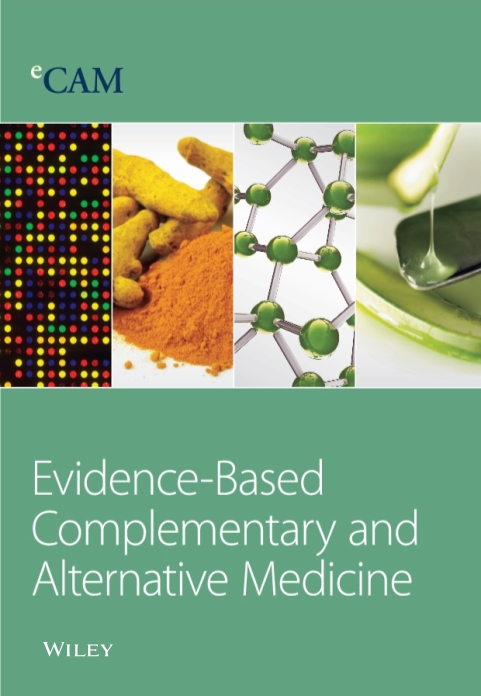Potential JAK2 Inhibitors from Selected Natural Compounds: A Promising Approach for Complementary Therapy in Cancer Patients
4区 医学
Q2 Medicine
Evidence-based Complementary and Alternative Medicine
Pub Date : 2024-04-26
DOI:10.1155/2024/1114928
引用次数: 0
Abstract
Background. Janus-activated kinase 2 (JAK2) plays a pivotal role in numerous essential biological processes, including proliferation, apoptosis, and metastasis in human cells. Prior studies have indicated that inhibiting JAK2 could be a promising strategy to mitigate cell proliferation and induce apoptosis in tumor cells. Objectives. This study aimed to estimate the binding affinity of 79 herbal compounds, comprising 46 flavonoids, 21 anthraquinones, and 12 cinnamic acids, to the ATP-binding cleft of JAK2 to identify potential herbal inhibitors of JAK2. Methods. The binding affinities between ligands and JAK2 were calculated utilizing AutoDock 4.0 software in conjunction with the Cygwin environment. Cross-validation was conducted using the Schrödinger tool. Molecular dynamics simulations were employed to evaluate the stability of docked poses for the most significant JAK2 inhibitors. Furthermore, the Discovery Studio Visualizer tool was utilized to elucidate interactions between the top-ranked JAK2 inhibitors and residues within the JAK2 ATP-binding site. Results. Twelve flavonoids, two anthraquinones, and three cinnamic acids demonstrated substantial binding affinities to the protein kinase domain of the receptor, with a criterion of < −10 kcal/mol. Among the studied flavonoids, anthraquinones, and cinnamic acid derivatives, orientin, chlorogenic acid, and pulmatin emerged as the most potent JAK2 inhibitors, exhibiting scores of −14.49, −11.87, and −10.76 kcal/mol, respectively. Furthermore, the docked poses of orientin, pulmatin, and chlorogenic acid remained stable throughout 60 ns computer simulations. The average root mean square deviation values calculated for JAK2 when complexed with orientin, chlorogenic acid, and pulmatin were 2.04 Å, 2.06 Å, and 1.95 Å, respectively. Conclusion. This study underscores the robust inhibitory potential of orientin, pulmatin, and chlorogenic acid against JAK2. The findings hold promise for the development of novel and effective drugs for cancer treatment.从精选天然化合物中提取的潜在 JAK2 抑制剂:癌症患者有望采用的辅助疗法
背景。Janus-activated kinase 2(JAK2)在人类细胞的增殖、凋亡和转移等众多重要生物过程中发挥着关键作用。先前的研究表明,抑制 JAK2 可能是减轻细胞增殖和诱导肿瘤细胞凋亡的一种有前途的策略。研究目的本研究旨在估算 79 种中草药化合物(包括 46 种黄酮类化合物、21 种蒽醌类化合物和 12 种肉桂酸类化合物)与 JAK2 的 ATP 结合裂隙的结合亲和力,以确定潜在的 JAK2 中草药抑制剂。研究方法配体与 JAK2 之间的结合亲和力是在 Cygwin 环境下利用 AutoDock 4.0 软件计算得出的。使用薛定谔工具进行交叉验证。分子动力学模拟用于评估最重要的 JAK2 抑制剂对接姿势的稳定性。此外,还利用 Discovery Studio Visualizer 工具阐明了排名靠前的 JAK2 抑制剂与 JAK2 ATP 结合位点内残基之间的相互作用。结果。12种黄酮类化合物、2种蒽醌类化合物和3种肉桂酸与受体蛋白激酶结构域的结合亲和力很高,标准为< -10 kcal/mol。在所研究的黄酮类化合物、蒽醌类化合物和肉桂酸衍生物中,荭草苷、绿原酸和pulmatin是最有效的JAK2抑制剂,它们的得分分别为-14.49、-11.87和-10.76 kcal/mol。此外,在 60 ns 的计算机模拟过程中,Orientalin、pulmatin 和绿原酸的对接位置保持稳定。计算得出的 JAK2 与荭草素、绿原酸和 pulmatin 复合物的平均均方根偏差值分别为 2.04 Å、2.06 Å 和 1.95 Å。结论本研究强调了荭草苷、豆黄素和绿原酸对 JAK2 的强大抑制潜力。这些发现为开发新型有效的癌症治疗药物带来了希望。
本文章由计算机程序翻译,如有差异,请以英文原文为准。
求助全文
约1分钟内获得全文
求助全文
来源期刊
自引率
0.00%
发文量
1983
审稿时长
2.2 months
期刊介绍:
Evidence-Based Complementary and Alternative Medicine (eCAM) is an international, peer-reviewed journal that seeks to understand the sources and to encourage rigorous research in this new, yet ancient world of complementary and alternative medicine.
The journal seeks to apply scientific rigor to the study of complementary and alternative medicine (CAM) modalities, particularly traditional Asian healing systems. eCAM emphasizes health outcome, while documenting biological mechanisms of action. The journal is devoted to the advancement of science in the field of basic research, clinical studies, methodology or scientific theory in diverse areas of Biomedical Sciences. The journal does not consider articles on homeopathy.

 求助内容:
求助内容: 应助结果提醒方式:
应助结果提醒方式:


